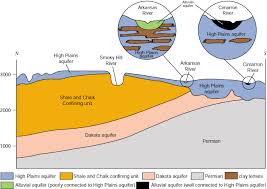Spatial Prediction of Chloride Concentration in Azarshahr plain Aquifer-Iran, Using EC, Ca and Mg as Auxiliary Co-kriging Variables
Keywords:
Cokriging; Kriging; Spatial prediction; Azarshahr; IranAbstract
For a less densely sampled Area, Lognormal ordinary cokriging (LnOCK) with auxiliary variables can sometimes improve estimates. In this study for groundwater quality assessment of Azarshahr plain aquifer- East Azerbaijan province- Iran (one of the Uromia lake sub-basins) 39 samples have been gathered. Due to slight sample accumulation, geostatistics was utilized for accuracy rising in Chloride concentration prediction of study area. For this purpose, three steps were designed; At first, spatial concentration of chloride has modelled by Lognormal ordinary kriging (LnOK), then three different covariant (EC, Ca and Mg ) that their quantities had more than 90% correlation to chloride, has been chosen for spatial prediction of its concentration separately and in third step EC and Ca have used together as covariates to evaluate the spatial prediction. Outcomes have shown that Lognormal ordinary cokriging (LnOCK) using Ca as an auxiliary covariant reveals more efficient results; With Mean error about 0.04 and RMSE about 0.26. Whereas adding more data set as excess covariant (Ca and EC, together) reduced the model precision. Drown maps finally showed that Chloride concentration rises from the South-East to North-West in study area.
References
Ahmadi, S.H., Sedghamiz, A., 2007. Geostatistical analysis of spatial and temporal variations of groundwater level. Env. Monit Assess doi. 10. 1007/ s10661-006-9361-z.
ARWA, 2009. Detailed data collection from discharges of pumping wells and Qanats in the Azarshahr Plain. Report in Persian.
Asghari Moghaddam, A., 1991. The hydrogeology of the Tabriz area, Iran. Unpublished PhD thesis.
Diggle, P., Ribeiro Jr, P.J., 2007. Model-based Geostatistics. Springer Science +Business Media, LLC, New York.
Freeze, R.A., Cherry, J.A., 1979. Groundwater, Prentice Hall, New Jersey.
Ghadermazi, J., Sayyad, G.h., Mohammadi, J., Moezzi, A., Ahmadi, F., Schulin, R., 2011. Spatial Prediction of Nitrate Concentration in Drinking Water Using pH as Auxiliary Co-kriging Variable, 1st Conference on Spatial Statistics. Procedia Env. Sci., 3,130-135.
Goovaerts, P., 1997. Geostatistics for natural resources evaluation. Oxford University Press, New York.
Hani, A., 2010. Spatial Distribution and Risk Assessment of As, Hg, Co and Cr in Kaveh Industrial City, using Geostatistic and GIS. Inter. J. Env. Earth Sci., 1, 38-43.
Hengl, T., 2009. A Practical Guide to Geostatistical Mapping. Self-Published book on www.lulu.com.
Hounslow, A.W., 1995.Water Quality Data Analysis and Interpretation. Lewis Publishers, New York.
Isaaks, E., Srivastava, R.M., 1989. An introduction to applied geostatistics. Oxford University Press, New York.
Issar, A., 1969. The groundwater provinces of Iran. Bull Inter Assoc. Sci. Hydrol. XIV.
Lei, D., Yongzhang, Z., Jin, M., Yong, L., 2008. Using Multivariate Statistical and Geostatistical Methods to Identify Spatial Variability of Trace Elements in Agricultural Soils in Dongguan City, Guangdong, China. J. China Uni. Geosci., 4, 343-353.
Moasheri, A., tabatabai, S., Sarani, N., Alai, Y., et al., 2012. Estimation Spatial distribution of Sodium adsorption ratio (SAR) in Groundwater’s Using ANN and Geostatistics Methods, the case of Birjand Plain, Iran. Inter. Conf. Chem. Eco. Env.Sci., (ICEES'2012) march 17-18, Bangkok.
Moinvaziri, H., Aminsobhani, I., 1978. Volcanological and volcanosedimentological study of Sahand Mountain. University of Tarbeyat Moallim, Tehran, Report in Persian.
Nourani, V., 2012. Conjugation of Artificial Neural Network and Geostatistics Approaches for Groundwater Modeling. Recent. Res. Env.Geol. Sci., 4, 461-469.
Reghunath, R., Murthy, T.R., Raghavan, B.R., 2005. Time series analysis to monitor and assess water resources: A moving average approach. Env. Monit Assess., 109, 65-72.
Rostami Zad, G., Karimi, B., Nahvinia, M. J., 2011. Spatial estimation of SAR and CL in ground water using cokriging and kriging methods. Elixir Agri., 36, 3204-3209.
Sameer, V., Yamakanamardi, Hampannavar, U.S., Purandara, B.K., 2011. Assessment of chloride concentration in groundwater: A case study for Belgaum City. Inter. J. Env. Sci., 2, 271-280
Todd, D.K., Mays, L.W., 2005. Groundwater Hydrology.Wiley, New York.
Voudouris, K., Mandilaras, D., Antonakos, A., 2004. Methods to Define the Area Distribution of the Salt Intrusion: Examples from South Greece., 18 SWIM, Cartagena, Spain.
Webster, R., Oliver, M.A., 2001. Geostatistics for environmental scientists. Wiley, London.

Published
How to Cite
Issue
Section
Copyright (c) 2014 Alireza Docheshmeh Gorgij, Asghar Asghari Moghaddam

This work is licensed under a Creative Commons Attribution-NonCommercial-NoDerivatives 4.0 International License.



